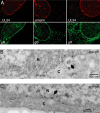Herpes simplex virus glycoproteins gB and gH function in fusion between the virion envelope and the outer nuclear membrane
- PMID: 17548810
- PMCID: PMC1891206
- DOI: 10.1073/pnas.0703790104
Herpes simplex virus glycoproteins gB and gH function in fusion between the virion envelope and the outer nuclear membrane
Abstract
Herpesviruses must traverse the nuclear envelope to gain access to the cytoplasm and, ultimately, to exit cells. It is believed that herpesvirus nucleocapsids enter the perinuclear space by budding through the inner nuclear membrane (NM). To reach the cytoplasm these enveloped particles must fuse with the outer NM and the unenveloped capsids then acquire a second envelope in the trans-Golgi network. Little is known about the process by which herpesviruses virions fuse with the outer NM. Here we show that a herpes simplex virus (HSV) mutant lacking both the two putative fusion glycoproteins gB and gH failed to cross the nuclear envelope. Enveloped virions accumulated in the perinuclear space or in membrane vesicles that bulged into the nucleoplasm (herniations). By contrast, mutants lacking just gB or gH showed only minor or no defects in nuclear egress. We concluded that either HSV gB or gH can promote fusion between the virion envelope and the outer NM. It is noteworthy that fusion associated with HSV entry requires the cooperative action of both gB and gH, suggesting that the two types of fusion (egress versus entry) are dissimilar processes.
Conflict of interest statement
The authors declare no conflict of interest.
Figures




References
-
- Stuurman N, Heins S, Aebi U. J Struct Biol. 1998;122:42–66. - PubMed
Publication types
MeSH terms
Substances
Grants and funding
LinkOut - more resources
Full Text Sources

